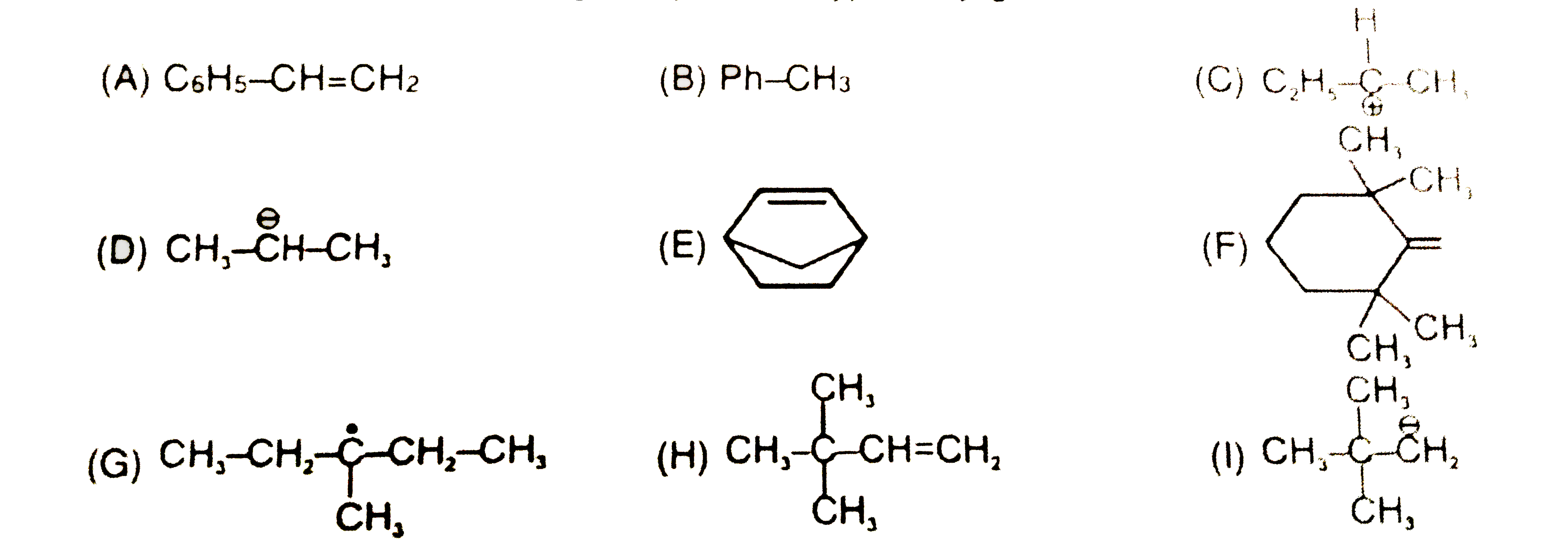Which one of the following has inductive, mesomeric and hyperconjugation effect?
The correct Answer is:C
To determine which compound exhibits inductive, mesomeric, and hyperconjugation effects, we will analyze each option step by step.
Step 1: Understanding the Effects
1. Inductive Effect (−I): This is the permanent effect due to the electronegativity of atoms or groups that withdraw electron density through sigma bonds.
2. Mesomeric Effect (−M or +M): This is the effect due to the delocalization of electrons in a molecule, typically involving π bonds and lone pairs.
3. Hyperconjugation: This is the interaction of the electrons in a σ bond (usually C-H or C-C) with an adjacent empty or partially filled p-orbital or π-bonding orbital.
Step 2: Analyzing Each Option
1. Option A: CH3Cl
- Inductive Effect: Chlorine is electronegative, so it exhibits a −I effect.
- Mesomeric Effect: There is no mesomeric effect because there are no π bonds or lone pairs to delocalize.
- Hyperconjugation: There is no hyperconjugation effect as there are no adjacent hydrogen atoms on an α-carbon.
- Conclusion: CH3Cl has only the inductive effect.
2. Option B: CH3-CH=CH2
- Inductive Effect: There is no significant inductive effect present.
- Mesomeric Effect: There is no mesomeric effect due to lack of conjugation.
- Hyperconjugation: There is hyperconjugation due to the presence of α-hydrogens.
- Conclusion: This compound has only hyperconjugation.
3. Option C: CH3-CH=CH-CO-CH3
- Inductive Effect: The carbonyl oxygen is electronegative, so it exhibits a −I effect.
- Mesomeric Effect: The carbonyl group can participate in resonance, showing mesomeric effects.
- Hyperconjugation: The α-carbon has three hydrogen atoms, allowing for hyperconjugation.
- Conclusion: This compound exhibits all three effects.
4. Option D: CH3-CH=CH-CH2-COOH
- Inductive Effect: The carboxylic acid group can exhibit a −I effect.
- Mesomeric Effect: There is a mesomeric effect due to the carboxylic acid.
- Hyperconjugation: There is hyperconjugation due to the presence of α-hydrogens.
- Conclusion: This compound has mesomeric and hyperconjugation effects but lacks a significant inductive effect.
Final Answer
The compound that exhibits inductive, mesomeric, and hyperconjugation effects is Option C: CH3-CH=CH-CO-CH3.
1. Inductive Effect (−I): This is the permanent effect due to the electronegativity of atoms or groups that withdraw electron density through sigma bonds.
2. Mesomeric Effect (−M or +M): This is the effect due to the delocalization of electrons in a molecule, typically involving π bonds and lone pairs.
3. Hyperconjugation: This is the interaction of the electrons in a σ bond (usually C-H or C-C) with an adjacent empty or partially filled p-orbital or π-bonding orbital.
1. Option A: CH3Cl
- Inductive Effect: Chlorine is electronegative, so it exhibits a −I effect.
- Mesomeric Effect: There is no mesomeric effect because there are no π bonds or lone pairs to delocalize.
- Hyperconjugation: There is no hyperconjugation effect as there are no adjacent hydrogen atoms on an α-carbon.
- Conclusion: CH3Cl has only the inductive effect.
- Inductive Effect: There is no significant inductive effect present.
- Mesomeric Effect: There is no mesomeric effect due to lack of conjugation.
- Hyperconjugation: There is hyperconjugation due to the presence of α-hydrogens.
- Conclusion: This compound has only hyperconjugation.
- Inductive Effect: The carbonyl oxygen is electronegative, so it exhibits a −I effect.
- Mesomeric Effect: The carbonyl group can participate in resonance, showing mesomeric effects.
- Hyperconjugation: The α-carbon has three hydrogen atoms, allowing for hyperconjugation.
- Conclusion: This compound exhibits all three effects.
- Inductive Effect: The carboxylic acid group can exhibit a −I effect.
- Mesomeric Effect: There is a mesomeric effect due to the carboxylic acid.
- Hyperconjugation: There is hyperconjugation due to the presence of α-hydrogens.
- Conclusion: This compound has mesomeric and hyperconjugation effects but lacks a significant inductive effect.
The compound that exhibits inductive, mesomeric, and hyperconjugation effects is Option C: CH3-CH=CH-CO-CH3.
Topper's Solved these Questions
- SOME BASIC PRINCIPALS OF ORGANIC CHEMISTRYBook:A2ZChapter:SOME BASIC PRINCIPALS OF ORGANIC CHEMISTRYExercise:Acid And Basic Strength
Explore 29 Videos
- SOME BASIC PRINCIPALS OF ORGANIC CHEMISTRYBook:A2ZChapter:SOME BASIC PRINCIPALS OF ORGANIC CHEMISTRYExercise:Bond Fission, Reagents, Reactive Intermediates And Their Stability
Explore 31 Videos
- SOME BASIC CONCEPTS OF CHEMISTRYBook:A2ZChapter:SOME BASIC CONCEPTS OF CHEMISTRYExercise:Section D - Chapter End Test
Explore 30 Videos
- STATES OF MATTERBook:A2ZChapter:STATES OF MATTERExercise:Section D - Chapter End Test
Explore 30 Videos
Similar Questions
Knowledge Check
Which of the following group has the maximum hyperconjugation effect ?
ACH3−BCH3CH2−C(CH3)2CH−D(CH3)3C−Which of the following group has the maximum hyperconjugation effect ?
ACH3−BCH3CH2−C(CH3)2CH−D(CH3)3C−Which one of the following has inductive, mesomeric and hyperconjugation effect?
ACH3CIBCH3−CH−CH2CCH3CH=CHCOCH2CIDCH2=CH−CH2
In which of the following molecules all the effects namely inductive, mesomeric and hyperconjugation operate?
View SolutionIn which of the following all electronic effects namely inductive, mesomeric and hyperconjugative effects are present?
View SolutionWhich of the following species is/are stabilised hyperconjugation ?
View SolutionWhich of the following group has maximum hyper conjugation effect but minimum inductive effect
View SolutionWhich of the following σ bonds participate in hyperconjugation ?

View Solution


